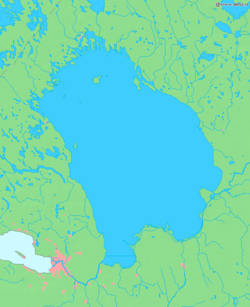
Proto-Karelian, [1] [2] [3] also known as Old Karelian, [4] [5] was a language once spoken on the western shore of Lake Ladoga in Karelia, from which the dialects of the Karelian language (White, Southern and Livvi), Ludic, the Ingrian language, [6] as well as the South Karelian and Savonian dialects of the Finnish language have developed. [7] It was spoken around the 12th and 13th centuries. [8] The Eastern Finnish dialects developed from Proto-Karelian when the language of the inhabitants who had moved to the area around present-day Mikkeli mixed with western, likely Tavastian, speakers of Finnish. The Livvi-Karelian dialect and Ludic developed from the mixture of the old Vepsian language spoken by the Vepsians of the Olonets Isthmus and Proto-Karelian. [9] [10] [11] [12]
Innovations in Proto-Karelian include: the disappearance of *d and *g between vowels, the plural stem *-lOi-, the labialization of *e in post-syllables before labial consonants and the use of "männä" (with ä instead of e) for the word "mennä" (to go). [13] [14] The Old Karelian language had already been in contact with Old Russian speakers within its early stages. [15]
